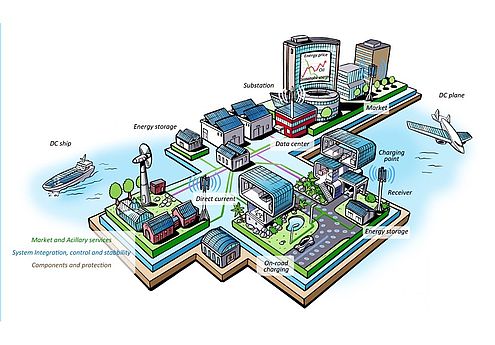DC Distribution Smart Grids
Direct Current (DC) Distribution Smart Grids

Project description
DC Distribution Smart Grids project (DCSMART) is accepted by the EU within the program ERANET (European Research Area Network) of Horizon 2020 . The main applicants are Pavol Bauer and Laura Ramirez Elizondo as well as Ernst Harting for the overall management of the project. This project means 4 PhD positions and two postdoc positions for TU Delft and TUe divided between Electrical Engineering, Technology Policy and Management, Architecture and Computer science faculties. The project partners are also Direct Current BV (Harry Stokman, Fraunhofer (Bernd Wunder), Centre Suisse dElectronique et Microtechnique SA (Pierre-Jean Ale) with more PhD positions in Germany and Switzerland.
Background
The electrical power system is facing challenges due to the increasing amount of distributed energy resources with stochastic behaviour. While the distribution grid has traditionally operated with alternating current (ac), nowadays most devices operate with direct current (dc) internally, and most distributed renewable resources generate power in dc. Moreover, storage components as batteries and supercapacitors have a dc character.
DCSMART is an interdisciplinary project that aims at enabling a straightforward integration of smart grid system technologies, creation of market opportunities and stakeholders adoption through the development and implementation of dc distribution smart grids. The dc distribution smart grids will be based on modular and scalable concepts and will be validated in two demonstration sites, one in the Netherlands and one in Switzerland. Innovative smart markets and smart grid applications such as active demand side management will be implemented.
DC distribution grids have the potential to facilitate smart grid applications in a more straightforward way. With dc distribution grids, dc sources and dc loads could be directly
connected to a dc bus, eliminating dc/ac and ac/dc conversions. Not only would the amount of conversion steps be reduced, but also the need for frequency synchronization would be eliminated. Power converters offer flexibility to the system, a very important attribute for the
deployment of smart grid applications. In dc distribution grids the participation of power converter devices is more pronounced than in ac distribution grids. By making appropriate use of this attribute, smart grid technologies can be more easily enabled in dc distribution grids, as the power converters provide more controllability and as a result, are more suitable for the Implementation of ICT-based smart grid applications, such as active demand side management.